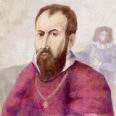Melozzo da Forlì facts for kids
Quick facts for kids
Melozzo da Forlì
|
|
|---|---|

self-portrait
|
|
| Born | c. 1438 |
| Died | 1494 (aged 55–56) |
| Education | Forlì painting school |
| Known for | Painting, architecture |
|
Notable work
|
Frescoes of the Basilica dei Santi Apostoli (Rome), Basilica della Santa Casa (Loreto) |
| Movement | Italian Renaissance |
| Patron(s) | Ansuino da Forlì |
Melozzo da Forlì (born around 1438, died 1494) was an important Italian painter and architect during the Italian Renaissance. He was known for his amazing fresco paintings. Frescoes are paintings done on wet plaster walls. Melozzo was especially good at a technique called foreshortening. This made his painted figures look like they were coming out of the wall! He was a key artist from the Forlì painting school.
Contents
Melozzo's Life and Art
Melozzo was likely from a rich family in Forlì, Italy. We don't know much about his early life. Some people think he learned art in Forlì from artists like Ansuino da Forlì. Both were influenced by the famous painter Andrea Mantegna.
Around 1460, Melozzo was first mentioned in his hometown. He worked with Antoniazzo Romano to paint frescoes in the Bessarione chapel in the Basilica dei Santi Apostoli in Rome.
Time in Urbino
Melozzo probably moved to Urbino between 1465 and 1474. There, he met Piero della Francesca, another great painter. Piero greatly influenced Melozzo's style and how he used perspective in his art. Perspective makes things look far away or close up.
Melozzo also studied the architecture of Bramante. He looked at the work of Flemish painters who were working for Duke Federico da Montefeltro. Melozzo might have helped decorate the studiolo (a small study room) in Urbino's famous Ducal Palace.
Working in Rome
Around 1472-1474, Melozzo moved to Rome. In 1477, he finished a big fresco called Sixtus IV Appointing Platina as Librarian of the Vatican Library. This painting is now in the Pinacoteca Vaticana (Vatican Art Gallery).
In the same year, Girolamo Riario built his palace in Rome, now called Palazzo Altemps. Melozzo helped with the designs. In 1478, Melozzo became one of the first members of the Academy of St Luke. This group was started by Pope Sixtus IV to bring together the main painters in the city.
Around 1472-1474, Melozzo was asked to paint the ceiling of the apse (a curved part) in the basilica dei Santi Apostoli in Rome. His painting showed the Ascension of Christ. In this work, Jesus is painted using bold foreshortening. This fresco was taken down in 1711. The figure of Christ is now in the Quirinal Palace. Other parts of the fresco, which influenced the famous painter Raphael, are in the sacristy of St Peter's. A hall in the Vatican Museums has designs of angels and apostles from this same fresco. Another painting from his time in Rome is an Annunciation in the Pantheon.
Melozzo's last work in Rome was a chapel in the church of Santa Maria in Trastevere, which is now gone.
Later Years
After Pope Sixtus IV died in 1484, Melozzo moved from Rome to Loreto. There, he painted a fresco in the dome of the sacristy of San Marco in the Basilica della Santa Casa. This was one of the first times a dome was decorated with both architecture and figures. It greatly influenced the Camera degli Sposi by Mantegna.
In 1489, Melozzo returned to Rome. He likely drew some designs for mosaics of Jesus blessing in the Chapel of St Helena. This chapel is in the basilica of Santa Croce in Gerusalemme.
Melozzo also painted a dome in a church in Forlì, which was destroyed in 1651. He may have painted portraits of famous people like Plato and Dante in Urbino. These portraits are now in different collections. In 1493, he worked on some ceilings in the Palazzo Comunale of Ancona, which are now lost.
Finally, Melozzo returned to Forlì. There, with his student Marco Palmezzano, he decorated the Feo Chapel in the church of San Biagio. This chapel was destroyed during World War II. The Pinacoteca (art gallery) of Forlì has a fresco by Melozzo called the "Pestapepe," or Pepper-grinder. It was originally a sign for a grocer's shop. It shows a lively, realistic scene and is Melozzo's only painting about everyday life.
Melozzo died in November 1494 in Forlì. He is buried in the Church of the Santissima Trinita (Most Holy Trinity).
Melozzo's Legacy
Even though only a few of Melozzo's works still exist, art experts agree he helped art move forward. He was not known for his use of color, but he painted with great care. His figures were fine and dignified. His special way of using perspective influenced many other painters.
Melozzo's works look a bit like those of his friend Andrea Mantegna. Marco Palmezzano was a student of Melozzo. Some of Palmezzano's works were even thought to be by Melozzo because they signed them "Marcus de Melotius."
Melozzo's paintings had a strong influence on very famous artists like Michelangelo, Raphael, and Donato Bramante.
Images for kids
See also
 In Spanish: Melozzo da Forlì para niños
In Spanish: Melozzo da Forlì para niños

